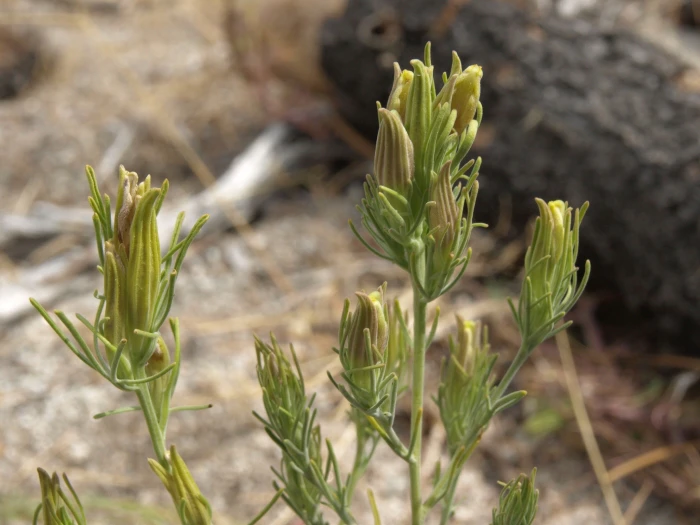Bushy Bird’s Beak
(Cordylanthus ramosus)
Bushy Bird’s Beak (Cordylanthus ramosus)
/
/

Jim Morefield
CC BY 4.0
Image By:
Jim Morefield
Recorded By:
Copyright:
CC BY 4.0
Copyright Notice:
Photo by: Jim Morefield | License Type: CC BY 4.0 | License URL: http://creativecommons.org/licenses/by/4.0/ | Rights Holder: Jim Morefield | Publisher: iNaturalist | Date Created: 2013-08-19T11:22:11-07:00 |
























Estimated Native Range
Climate Requirements
| • Precipitation | 5" - 50" |
| • High Temp. | 68°F - 98°F |
| • Low Temp. | -2°F - 28°F |
Summary
Cordylanthus ramosus, commonly known as Bushy Bird’s Beak, is an annual herb native to the semi-arid shrublands and sagebrush communities of the Great Basin in the western United States. It typically inhabits areas with alkaline soils, often in valleys or on hillsides. This plant has an erect, branching form that can reach up to 2 feet in height, often displaying a reddish tint in its stems. The narrow, linear leaves may be simple or divided into thready lobes, adding to its feathery appearance. From late summer to early fall, Bushy Bird’s Beak produces an inflorescence of small, inconspicuous flowers; each has a hairy yellow pouch enclosed by reddish sepals, which are not particularly showy but have a unique charm.
Bushy Bird’s Beak is valued for its drought tolerance and ability to thrive in challenging soil conditions, making it suitable for xeriscaping and restoration projects in arid environments. It requires minimal maintenance once established. In cultivation, it prefers full sun exposure and well-drained, alkaline soils, mimicking its natural habitat. While not commonly used in ornamental horticulture, it can be an interesting addition to native plant gardens. Historically, the Navajo people used it medicinally as an emetic, although it is not widely used for this purpose today. Care should be taken when handling this plant, as it may cause skin irritation in some individuals.CC BY-SA 4.0
Bushy Bird’s Beak is valued for its drought tolerance and ability to thrive in challenging soil conditions, making it suitable for xeriscaping and restoration projects in arid environments. It requires minimal maintenance once established. In cultivation, it prefers full sun exposure and well-drained, alkaline soils, mimicking its natural habitat. While not commonly used in ornamental horticulture, it can be an interesting addition to native plant gardens. Historically, the Navajo people used it medicinally as an emetic, although it is not widely used for this purpose today. Care should be taken when handling this plant, as it may cause skin irritation in some individuals.CC BY-SA 4.0
Plant Description
- Plant Type: Herb
- Height: 1.5-3 feet
- Width: 1.5-3 feet
- Growth Rate: Rapid
- Flower Color: Purple, Yellow
- Flowering Season: Summer
- Leaf Retention:
Growth Requirements
- Sun: Full Sun, Part Shade
- Water: Medium
- Drainage: Medium
Common Uses
Butterfly Garden, Drought Tolerant, Low Maintenance
Natural Habitat
Semi-arid shrublands and sagebrush communities
Other Names
Common Names: Chaparral Bird’s Beak, Branched Bird’s Beak, Bushy Birdbeak, Much-Branched Bird’s-Beak
Scientific Names: Cordylanthus ramosus, Adenostegia ramosa, Adenostegia ramosa, Adenostegia ramosa var. macrocephalus, Cordylanthus ramosus, Cordylanthus ramosus subsp. ramosus, Cordylanthus ramosus subsp. setosus, Cordylanthus ramosus var. puberulus
GBIF Accepted Name: Cordylanthus ramosus